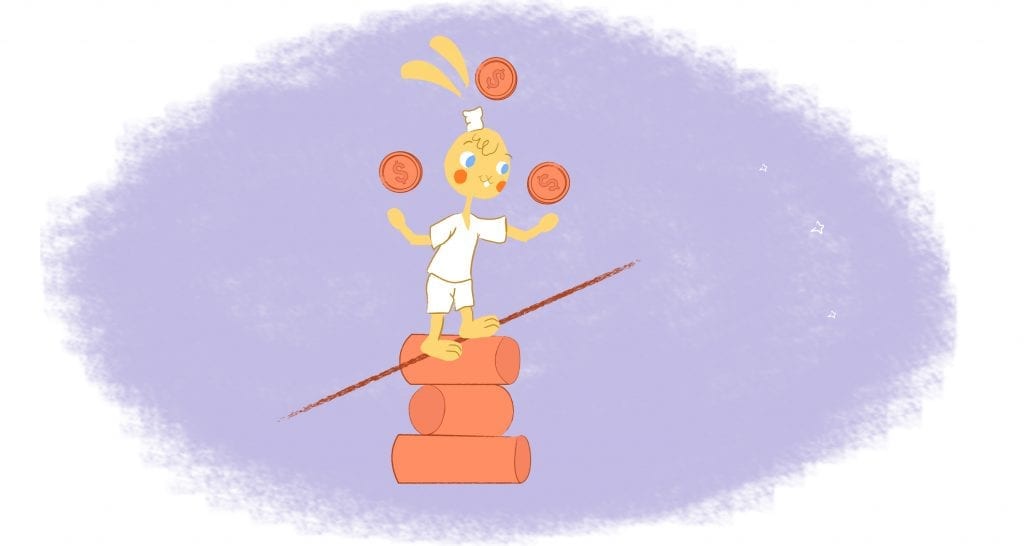

Do you feel like time is slipping away from you? It’s common to feel overwhelmed and unproductive, juggling work, family, and personal goals, along with the constant distractions of the digital age. Moreover, the reason for burnout is too many tasks and insufficient time. In fact, too many tasks and not enough time contribute to 78.7% of burnout.
However, if you harness the power of the 5 P’s of time management, you will gain a new level of productivity and fulfillment. And, most importantly, avoid the dangers of burnout.
Prioritize ruthlessly.
As a starting point, you must realize that not all tasks are equal. To ensure your to-do list moves the needle toward your goals, identify the high-impact activities that will significantly impact your goals.
To put it another way, think about what you can accomplish today that will have the biggest positive impact on your future.
Of course, that’s not always as simple as it sounds. So, you’ll want to begin now to prioritize ruthlessly.
Despite its intense sound, ruthless prioritization is a matter of focusing on what matters most. The following steps can help you prioritize ruthlessly:
Before you prioritize.
- Know your goals. In the absence of clear goals, prioritizing becomes a guessing game. So, establish your short-term and long-term goals, both personally and professionally. You will use them as a compass.
- Track your time. Do you know where your time goes? Take a few days to track your activities and be honest with yourself. As a result, time-wasters and hidden priorities are more easily identified.
The ruthless act of prioritizing.
- Start with the “only I can do” tasks. Is there anything that only you can handle that profoundly impacts your goals? Those are your non-negotiables.
- Apply the Eisenhower Matrix. Sort your tasks by urgency and importance. Don’t waste your time on unimportant tasks. Delegate or reschedule those that are less urgent and pay attention to those that are urgent.
- Embrace the “1 Yes, 3 Less” rule. If you accept a new task, identify three lesser-important tasks that can be cut or delegated. By doing this, you keep your plate manageable.
- Say no effectively. If a request doesn’t align with your priorities, don’t be afraid to decline it. Clearly explain your reasoning — if you want to — but in a polite yet firm manner.
Staying ruthless.
- Time blocking. Schedule the tasks you can do only yourself and the high-priority activities you must complete in your calendar.
- Review and adjust. Continually evaluate your priorities and make adjustments as needed. Flexibility is key as your goals and circumstances may change over time.
- Allow yourself to feel uncomfortable. Getting rid of things can be difficult. Don’t forget, however, that you are making space for the important things in your life.
- Embrace imperfection. There will be times when you will not get it right, and that’s okay. Keep refining your approach after learning from your mistakes.
Prioritizing ruthlessly is a skill that requires practice. If you remain patient and follow the above, it won’t take long for you to see significant improvements in your productivity and sense of accomplishment.
Plan meticulously.
Once you’ve determined your priorities, create a roadmap to achieve them. Here are a few ideas to get you started:
- Define your goals. What are you trying to accomplish? Be specific and break large goals down into smaller, actionable steps.
- Gather information. Do you need any resources? Is there anything that could stand in your way? You should research and gather all the relevant information to your goal.
- Choose your planning method. You can plan using a variety of techniques and strategies — including mind maps, bullet journals, and digital calendars. Take the time to experiment and discover what works best for you.
- Schedule your time. Each task should be scheduled at a specific time. Plan your day realistically and add buffer time for unexpected events to happen.
- Be detailed. Think about the “what,” “how,” “when,” and “who” for each task. Do you need any resources? What will you do to finish it? When are you going to do it? Who else will be involved?
- Consider alternatives. If things don’t go as planned, what will you do? Having backup options can keep you on track and prevent you from getting off track.
- Be flexible. There are a few things that go precisely according to plan. Don’t be afraid to adjust your schedule or tasks if necessary. Don’t hesitate to ask whenever you need help or a delegated task.
- Track your progress. Keep track of your progress and review your plan regularly. Identifying areas for improvement and staying motivated will help you stay motivated.
- Celebrate your successes. No matter how small your accomplishments are, take time to acknowledge them. As a result, you will remain motivated and keep moving forward.
It is important to remember that planning isn’t about following rigid schedules. Instead, the goal is to create a framework for intentionality.
Power up with productivity tools.
Using technology to manage your time can be a great asset. At the same time, productivity tools work best when you know your needs, choose the right tools, and implement them strategically.
Here are some pointers to get you started:
Identify your needs.
- What challenges do you face in terms of productivity? Is it difficult to manage your time, stay focused, or procrastinate?
- What type of work do you do? Different tools suit different professions (e.g., project management, writing, communication).
- Which devices do you use? Choose tools compatible with your laptop, smartphone, or tablet to ensure seamless integration.
Explore and choose the right tools.
- Start with the basics. Use task management apps (Todoist, Trello), calendar apps (Google Calendar, Outlook), and note-taking apps (Evernote, OneNote) for core organization.
- Explore specialized tools. Consider options like RescueTime for time management, Superhuman for email management, Slack for collaboration, or Microsoft Teams for communication.
- Integrate your tools. Keeping context switching and data silos to a minimum requires tools that work together seamlessly.
- Read reviews and compare features. Take a look at user reviews, free trials, and compatibility with your workflow when choosing a tool.
Implement the tools strategically.
- Prioritize essential tasks. Be careful not to overload yourself with tools. Choose 1-2 that address your biggest pain points.
- Learn the tools inside-out. Utilize tutorials, guides, and support resources to reach their full potential.
- Customize and refine. Don’t let the tools dictate your workflow, but rather the other way around. You can adjust settings, create templates, and find the most convenient shortcuts.
Proactive mindset.
Rather than reacting to your schedule demands, cultivate a proactive approach. To do this, you must anticipate challenges, find solutions proactively, and take control of your time.
Constant distractions, for instance, kill productivity. As such, find out your biggest time-wasters, like social media, email notifications, and multitasking. Then, develop strategies to handle them, such as:
- Turning off notifications
- Silencing your phone during focused work periods
- Utilizing website blockers if necessary.
Remember, being proactive empowers you to overcome challenges and stay ahead of the curve.
Personal well-being.
Are you familiar with the metaphor, “You can’t pour from an empty cup?” If not, it simply means that making time for self-care should be considered a high priority. Why? You can’t achieve sustainable productivity without prioritizing your physical and mental health.
To that end, schedule time to enjoy activities that nourish you, such as exercise, meditation, time in nature, or time with loved ones. It’s also important to remember that taking breaks is not a sign of weakness. Instead, it’s a strategic investment in your focus and energy.
In short, having a well-rested and rejuvenated mind leads to productivity.
Bonus P: Procrastination Buster: Conquer the Time-Sucking Monster
In the world of time management, procrastination is the arch-nemesis. You can combat procrastination by:
- Identifying your triggers and constructing coping strategies.
- Breaking down large tasks into smaller, manageable chunks.
- Rewarding yourself for completing tasks.
- Eliminating distractions by creating a focused work environment.
It is important to remember that procrastination thrives on perfection. As such, be proud of your progress, not just the final result, and embrace the philosophy “done is better than perfect.”
Putting it All Together
Using the 5 P’s to guide you, you can unlock your full potential and conquer the chaos of life. The 5 P’s are a framework, not a formula. So, feel free to adapt them to your unique needs and preferences.
FAQs
What are the 5 P’s of Time Management?
The 5 P’s of Time Management are a framework for efficiently organizing and maximizing your time. They are as follows:
- Prioritize. Focus on the most important tasks first.
- Plan. Assign each task a certain amount of time and create a schedule.
- Productivity Tools. Streamline your workflow using technology.
- Proactive Mindset. Instead of reacting, be anticipatory and solution-oriented.
- Personal Well-being. To maintain energy and focus, prioritize self-care and rest.
What are the benefits of using the 5 P’s?
- Increased productivity. With the right tools and focus, you can accomplish more in less time.
- Reduced stress. When you know what needs to be done and have a plan, you’ll feel more in control.
- Improved work-life balance. It is possible to avoid burnout and develop a sustainable work schedule by prioritizing your personal well-being.
- Greater clarity and focus. The 5 P’s will declutter your mind and help you prioritize your priorities.
How can I use the 5 P’s to manage my time at work?
In both the personal and professional spheres, the same principles apply. Your work environment and responsibilities should be considered when adapting the methods.
What if I don’t have enough time for everything?
Keep your expectations realistic. Basically, be realistic about how much you can accomplish whenever you can, and delegate the things that don’t align with your priorities to free up some time.
How can I stay motivated to use the 5 P’s?
Take the time to review your progress regularly and to celebrate your successes. Ensure you keep your goals in mind and concentrate on the positive effects that effective time management can have on your life.
Image Credit: Bich Tran; Pexels











John Hall
John Hall is the co-founder of Calendar a scheduling and time management app. He’s also a keynote speaker that you can book at http://www.johnhallspeaking.com.